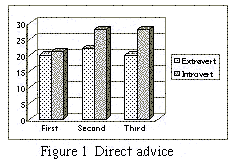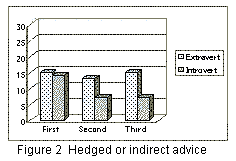|
Abstract
This paper explores how personality traits correlate with preferred advice giving styles. An analysis of a survey population of 70 Japanese university students shows that the Myers-Briggs Type Indicator (MBTI) scores partially correlate with the students' personality types and styles of giving advice in English.
Analysis shows that those students who are classed as introverts according to the MBPI use a more direct style of giving advice in letters than those who are extroverts. In a letter giving three consecutive pieces of advice, students of the two personality types used the same style in the first piece of advice before demonstrating differences in subsequent pieces of advice. It is suggested that the ideal ways to give advice are the same for both types of personality; however, as they continue giving advice these two types begin to use styles which are strongly related to their personalities.
Keywords: advice, personality, extrovert, introvert, MBTI

|


